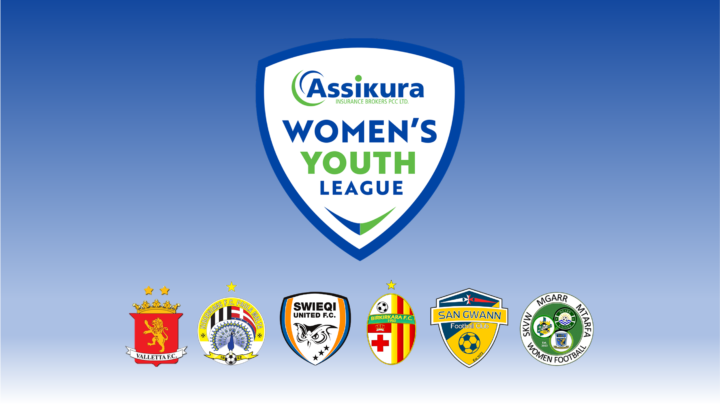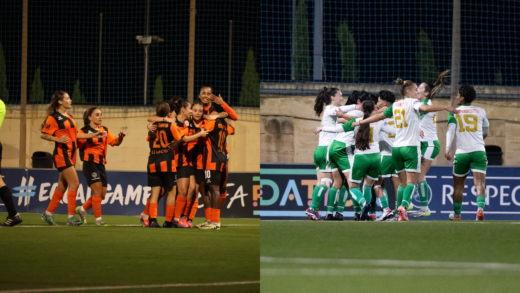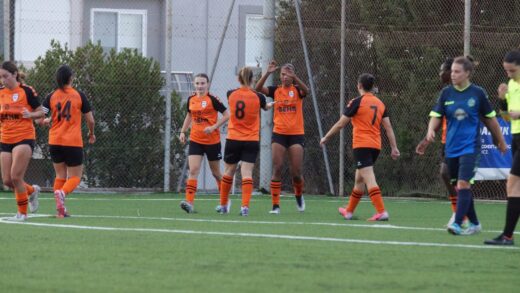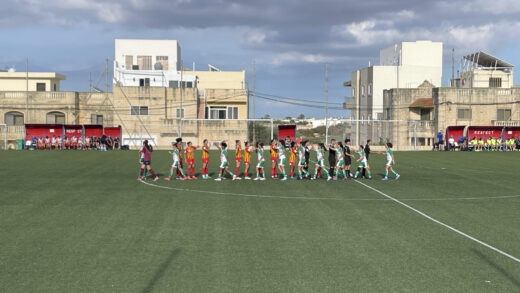Having undergone significant changes in its setup, the Assikura Women’s Youth League is well under way with most teams having played the first round. Below is a look at the standings, observations on some of the various changes and the bearing on player development, with insight from the coaches of the top three teams.
The Table
The Assikura Women’s Youth League is well under way with almost all of the teams having played each other at least once already. Swieqi United currently lead the title race having won all of the six games that they played, and with a game in hand. They are closely followed by Valletta who registered five wins and two losses to take their tally to fifteen. Birkirkara are in third with nine points, having lost the opportunity to do the double over Valletta to close the gap to them just before the break.
In the second half of the table are San Gwann and SKMM who are tied with five points, with Hibernians following suit on four points. Having said this, the Paolites have a game in hand over their rivals, albeit a tough test against leaders Swieqi United.

A look at the statistics shows that the three front-runners have had the exact same number of two clean sheets. However, Swieqi United lead in goals scored (22). Seventeen of those goals have been scored by the trio of Salamatu Abdulai (7), Kaysia Micallef (5) and Kim Fava (5). Valletta follow with 14 goals and having Francesca Bartolo (6) and Suzanne Farrugia Sacco (4) being the most prolific for the team. Meanwhile, Birkirkara follow with 9 goals, with Ileana Farrugia, Maia Gauci and Izabella Camilleri, having all scored twice in the league.
San Gwann and Hibernians registered one clean sheet each, while SKMM have not yet managed to keep their opponents out, but scored two more than their closest rivals. Chaimaa Tourki has been San Gwann greatest goal threat having grabbed 5 of their 7 goals. On the other hand, Estelle Borg has netted 3 of SKMM’s goals, while Hibernians have also shared the goals, with Martina Spiteri and Nyorah Celeste grabbing 2 each to lead the club’s list.
The numbers make for interesting reading, but as always such figures are not worth much in a vacuum. All teams have had to go through several changes from last season. Perhaps the fact that SKMM are newly formed and have five points bodes well for the side. There are also a number of teams who have undergone changes in coaching staff who may bring new methodologies and ideas. Furthermore, all teams have been affected by the fact that matches are being played on weekdays, as well as the change in age bracket from U21 to U19. Such changes of course affect the player availabilities, especially when considering that most players in the U19 league also either play in the senior league or the U16 league.
Taking Over A New Team
There are several teams who are being led by new coaches. One team who seem to have transitioned seamlessly are the league leaders Swieqi United, who are being led by Dorianne Theuma for the first time. She made the switch from Birkirkara after leading them to back-to-back titles, thus brings a good knowhow of the youth league landscape.
In fact, when probed on whether she is surprised at how quickly the team and her have been able to put philosophy into practice to get these results, Swieqi United’s coach conceded, “In a sense I knew plenty of characteristics of the players already between having either trained alongside them or having faced them as opponents in my previous stint as coach. However, of course then the aim is to try to implement my own methodology and philosophy.”
As for the fact that the team is unbeaten, the coach replied, “It is true that everyone enjoys winning, but my first aim, especially in youth categories, is always to learn and improve in performance. I am happy to say that I am working with players who are keen to learn.”
San Gwann were the team that got closest to getting points from the Owls, after mounting a comeback to change a potential 3-0 defeat into a 3-2 scoreline by two late goals. However, San Gwann faced a sterner side the second time round, where Swieqi United won the match by 2-0.
Probed on whether the two results display the growth of the team, Swieqi United’s coach responded, “The first match against San Gwann was just the second game that we had together as a team. We conceded the goals towards the end, perhaps this may be due it being early in the season so needing more time for me to get the philosophy across, as well as things like the fitness perhaps not being quite there yet. However, the second time around there was an improvement in possession, we were calmer and perhaps had a better idea of what we wanted to do as a team.”
This was only the second game where the current leaders did not concede a goal, the other being the match against Birkirkara which they also won by 2-0. Having said this, the scoreline is perhaps not representative of the pressure that the Stripes mounted in the match.
Birkirkara find themselves in third place and questioned on whether the current position is something they look to improve on, coach Pedro Dos Santos responded, “At this moment, the third place is not something we were looking for and so it cannot make us happy. We want to improve and go up in the table.”
As to successfully implementing his philosophy the coach said, “Considering that it is my first year with the players, and knowing that some of them have more than one coach during the week (U16s and/or Seniors), I am happy with what has been implemented during these months. Playing attractive football is tough and we are trying to get there. I trust the process for these players and I am sure they will play better.”
However, the coach is aware of the pressure that comes with coaching the team that is defending the title, “When you represent Birkirkara only one result matters, so in this case, there’s no extra pressure because we are the defending champions. We already know that every team wants to beat us because of what we represent as a club. Honestly I believe that for us it’s a good thing as it makes us work harder and keep focused for every game.”
Probed about the two teams that are currently occupying the two spots, the coach praised his opponents but is also looking at the bigger picture, “Swieqi United and Valletta are amazing teams, with great players and good coaches that are implementing their game model well. In my point of view, only work and consistency in our results, can make us reach higher places on the league table. We will continue working every day to improve our football and I believe at the end we will be better than we are now.”
Dealing With Squad Sizes, Injuries & Fixture Congestion
As noted above, the change in player age-brackets from U21 to U19 has understandably had an effect on all squad sizes. In turn, this likely has an effect on the number of injuries that teams contract, especially if one does not have the luxury of rotation.
One team that has evidently struggled with squad size is Birkirkara, who at times have lacked a substitute bench. Asked on the impact that this is having on the team’s season, coach Pedro dos Santos said, “Unfortunately, we lost some important players from last year and we have players still recovering from injuries which makes our job harder. However, we cannot use that as an excuse. We just need to find a way of working with the available players and make them play better, after all they are Birkirkara players.”
On the other hand, while having slightly bigger squads at this level, teams like SKMM, San Gwann and Valletta have a considerable number of players who are juggling two matches per week since they play both the senior and U19 league week in week out, with a few younger players doing the same but between the U19 and U16 league.
Despite Valletta being a new name, Denis Guerra is someone who has been developing this group of players for a few years. Probed about this, Guerra responded, “The fact that my players are playing both U19 and senior league matches each week is good because match practice is a good teacher and that means that they play close to 45 matches per season. This is close to what I used to see in Switzerland. I know that some players in Malta are playing just in one league but playing twenty matches is not enough. So, my idea has always been that I have one team who is playing two leagues and that is exactly what has brought the players to the level that they are at. They have a lot of match practice and good rhythm.”
However, the coach conceded that this balance is a tricky one to achieve with a limited squad size, “On the other hand, then of course playing so many matches with a group of twenty to twenty-two players means that sometimes they are a bit tired and also you risk some injuries. This is why I am sometimes a bit concerned with schedules of fixtures because we stop for two-three weeks but then my players have to play around three matches in a week when we continue. It is how it is and I try to rotate as much as possible, but this is part of the game.”
Player Development
Although the trophy is a seasonal target, the youth leagues serve as a pathway to bridge players’ development toward the senior league, whether locally or abroad.
As noted above, Valletta’s side is one of those whose majority of players are playing in both leagues consistently. Probed about the differences that a player has to adapt to when going into the senior league, Valletta’s Guerra responded, “What we lack in the senior league is the experience. In fact, a lot of games that we lose are due to silly mistakes which an experienced player would not make. So, that is most probably the reason which leads to different league positions in the respective leagues. I know that we are good at the younger level and of course now the aim is to become more competitive at the senior level.”
San Gwann and Mtarfa are two teams who also have a lot of players who also form part of the U19 league teams each week. Then there is a distribution of teams whose balance between established players and youth player introductions are more skewed, with some giving weekly minutes, while others are more selective.
A team that appears to sit in the middle of this distribution is Swieqi United. When probed about the balancing act between developing the future Swieqi United squad within the U19 league and having players regularly called into the senior team, coach Dorianne Theuma responded, “I would say the aim of any coach leading an U19 team is to provide players for the senior team. As a team, we have a number of players who are training and getting minutes with the senior team and this means that they gain more experience.”
However, the coach continued, “Personally besides the future with the senior team, it is important for me to see players getting called up with the national team. We currently have seven players who are called up with the U17, while Tammy Falzon has also been called up with the senior national team squad, which is a big opportunity. This is why I emphasise on performance, because in the end you want players to cement their position with the first eleven of the senior team and reach an even higher level when playing with the national team.”
This view is shared by Valletta’s coach Denis Guerra who when probed to stack the league season thus far in relation to their objectives responded in view of the long-term player development. He said, “When we started this project four years ago, our main aim was to develop players for the national team. So, at the time the players were around twelve years old so very young. With time we have been fighting at the top of the table and doing well in the minor categories for a few years. In fact, the target to have developed players for the national team is something that we achieved because last year we had a lot of players playing in the national team in their respective categories.” Among these is Georgiana Mifsud who was also called up to the senior national team against Haiti and also in the opening window of the UEFA Women’s Nations League.
Although in varied numbers, one notes that the majority of the clubs have players competing in the U19 league who also featured in previous U17 national team selections. As to the quality of the development, Malta’s U17 national team selection achieved a second-place finish in Malta’s return to the U17 Women’s EURO Championships in October after a two-year absence. The question now is whether the various clubs can continue developing players of this calibre regularly and improve further.
However, in terms of the short-term picture, the Assikura Women’s Youth League will be on hiatus until late December. At that point, the teams kick-on with their title charge and players will continue on their quest to impress and reach higher levels.
However, as noted above, until then, several players competing in the youth league have been called on international duty with the U17 national team selection to continue the development before returning with the club. Meanwhile, those looking for some inspiration can tune in to watch the senior national team embarking on the final two UEFA Women’s Nations League matches against Moldova (December 1st at 15:00 on TVM Sport+) and Latvia at the Centenary Stadium on 5th December at 16:00 (Tickets online).
Stay up to date by following The Sporting Fan on social media: Instagram ~ Facebook ~ X



